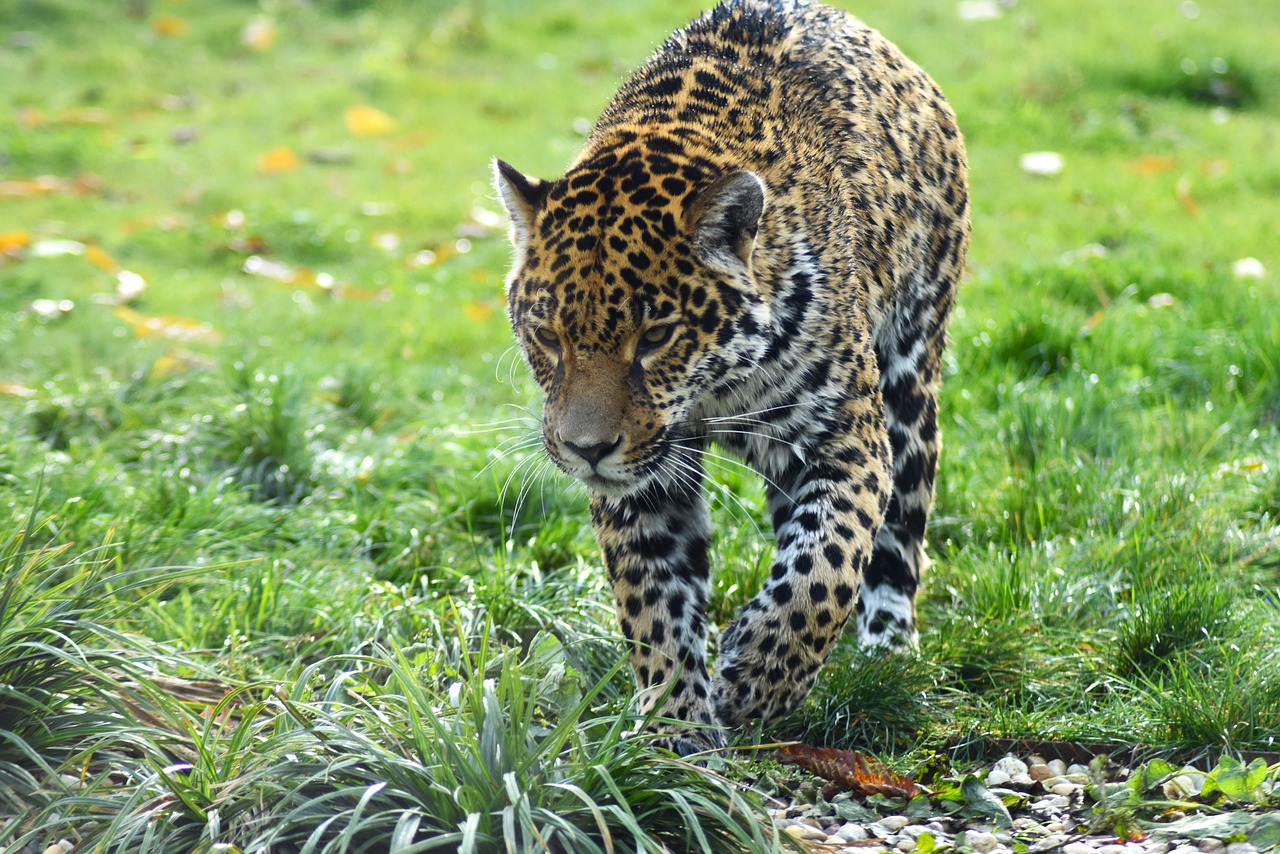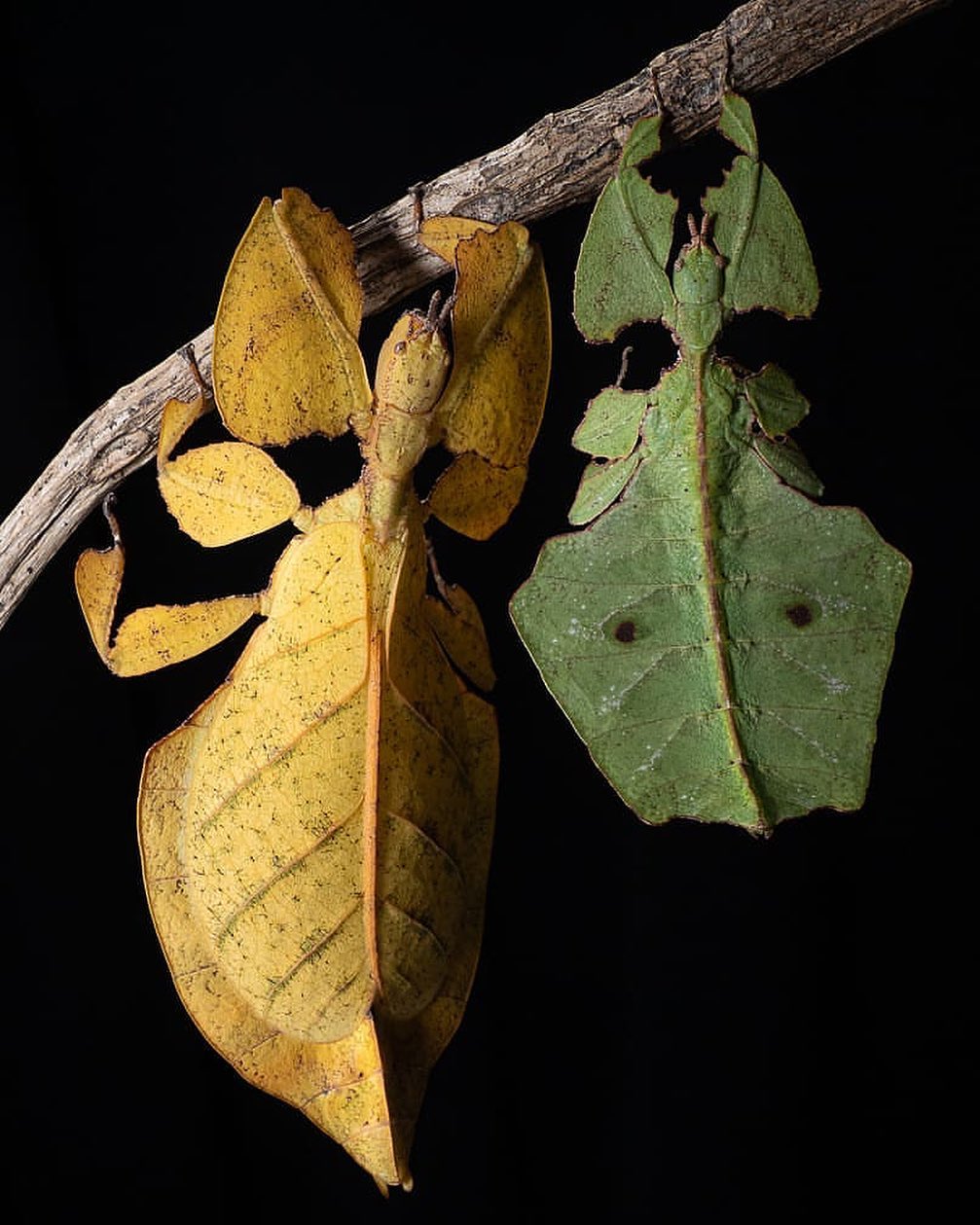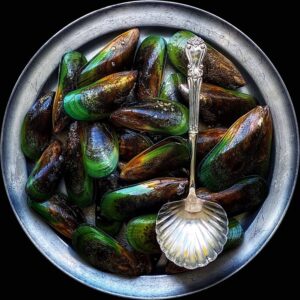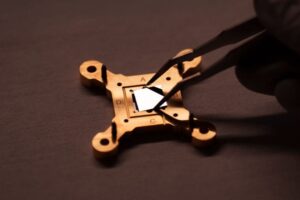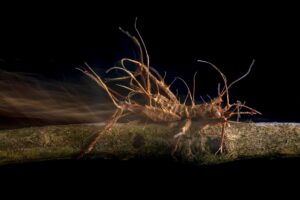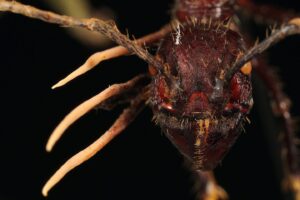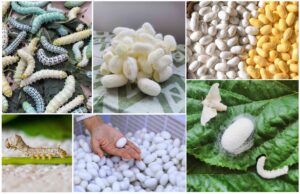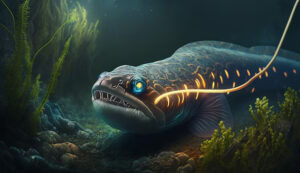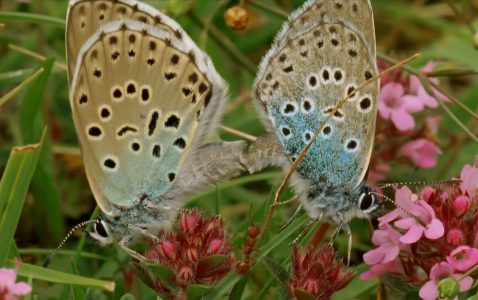 Pin
Pin Alcon Blue Butterflies / Photo source: BBC (Youtube Video SS)
Nature has its fair share of con artists, but few can match the audacious scheme pulled off by a small European butterfly. The Alcon Blue might look like any other delicate winged creature fluttering through wildflower meadows, but it harbors one of the most elaborate deception tactics in the animal kingdom.
This tiny trickster has mastered the art of infiltration so perfectly that it convinces entire ant colonies to raise its young as their own precious offspring. The story reads like a spy thriller, complete with chemical disguises, acoustic mimicry, and a level of manipulation that would make master criminals jealous. What makes this tale even more remarkable is that both species have been locked in this evolutionary arms race for millions of years, each developing increasingly sophisticated tricks and countermeasures.
Table of Contents
The Setup - A Butterfly's Unusual Beginning
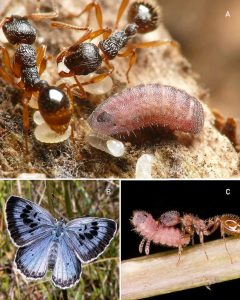 Pin
Pin The Setup of Alcon Butterfly life / Photo source Twitter
Most butterflies start life the traditional way: eggs laid on leaves, caterpillars munching plants, then transforming in a chrysalis. The Alcon Blue throws this playbook out the window with a strategy so bold it seems almost impossible. These butterflies begin their lives as regular caterpillars on wild thyme or cross-leaved gentian plants, but that’s where normal ends and extraordinary begins.
After just a few weeks of plant-eating, the caterpillar does something that defies logic—it deliberately falls to the ground and waits. This isn’t an accident or a moment of confusion. The little caterpillar has just initiated one of nature’s most daring heists, positioning itself to be “rescued” by passing ants who will unknowingly become its foster parents for the next ten months. This calculated drop marks the beginning of a deception so complete that the ants will actually treat the butterfly larva better than their own children.
The Chemical Disguise - Scent of Deception
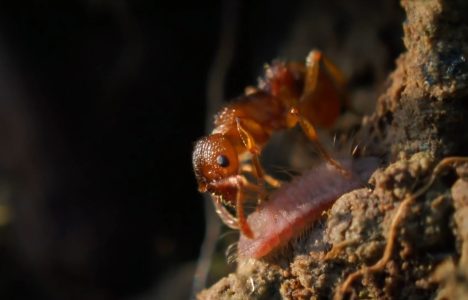 Pin
Pin Alcon Blue Butterfly Larvae carried by Ant / Photo source: BBC (Youtube Video SS)
The moment an ant worker discovers the fallen caterpillar, something remarkable happens at the molecular level. The Alcon Blue larva doesn’t just look helpless—it smells exactly like an ant baby. Through millions of years of evolution, these caterpillars have developed specialized glands that produce chemical compounds called cuticular hydrocarbons, the same waxy substances that coat ant larvae and tell the colony “this is family.”
Think of it like a perfect counterfeit passport that fools even the most experienced border guards. The ant worker picks up the caterpillar and carries it back to the nest, completely convinced it has found a lost member of the family. This chemical mimicry is so precise that different populations of Alcon Blues have evolved to match the specific scent signatures of their local ant species. It’s personalized fraud at its finest, with each butterfly population essentially speaking the local chemical dialect of their target ant neighbors.
Welcome Home - Inside the Ant Fortress
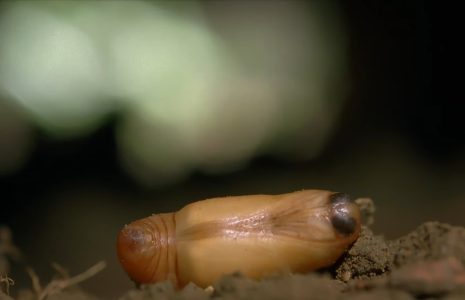 Pin
Pin Alcon Blue Butterfly chrysalis / Photo source: BBC (Youtube Video SS)
Once inside the ant nest, the Alcon Blue caterpillar faces its biggest test: convincing hundreds of adult ants that it belongs there. The underground world of an ant colony operates like a highly organized city, with strict social rules and constant communication between residents. Every ant knows their role, and strangers are typically attacked or expelled immediately. Yet the butterfly larva doesn’t just survive this scrutiny—it thrives in ways that seem almost magical.
The caterpillar gets placed in the nursery chambers alongside genuine ant larvae, where it continues its remarkable performance. Worker ants begin feeding it regurgitated food, grooming it carefully, and protecting it from any threats. What makes this even more incredible is that the ants can’t actually tell the difference between their own offspring and the imposter. The caterpillar has become so convincing that it triggers the same parental care instincts that the ants normally reserve for their own genetic family, turning natural protective behaviors into the perfect cover for this biological con game.
The Sound of Royalty - Acoustic Manipulation
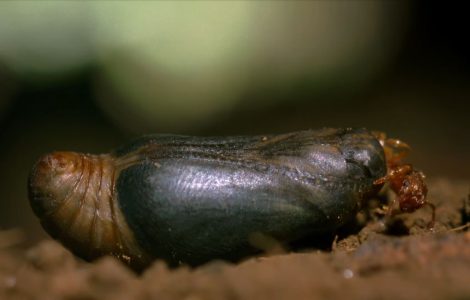 Pin
Pin Alcon Blue Butterfly Chrysalis / Photo source: BBC (Youtube Video SS)
Just when you think the Alcon Blue’s tricks couldn’t get more sophisticated, it reveals another layer of deception that borders on genius. The caterpillar doesn’t rely solely on chemical mimicry—it also learns to speak the ants’ language through sound. Deep within the nest, the butterfly larva produces specific acoustic signals by rubbing specialized body parts together, creating vibrations that travel through the ground and nest walls.
Here’s where the story takes an even more sinister turn: these sounds don’t just mimic ordinary ant larvae. The caterpillar actually imitates the acoustic signature of a queen ant. This means the worker ants don’t just treat it like family—they treat it like royalty. The butterfly larva receives priority feeding, premium protection, and gets carried to safety first during any nest emergencies. By mastering both chemical and acoustic deception, the caterpillar has essentially hacked the ant colony’s entire social hierarchy, positioning itself at the very top of their care priorities while their own biological offspring get second-class treatment.
The Price of Deception - A Deadly Feast
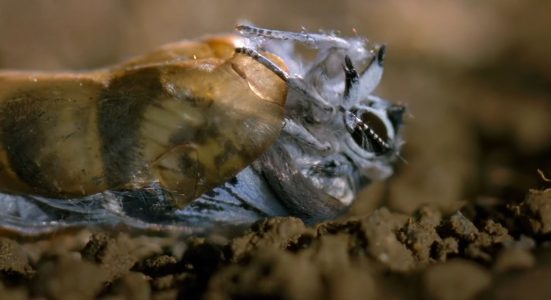 Pin
Pin Alcon Blue Butterfly ready for its first flight / Photo source: BBC (Youtube Video SS)
Living as an imposter in an ant colony comes with some dark realities that reveal just how far this evolutionary arms race has pushed both species. The Alcon Blue caterpillar doesn’t just freeload on the ants’ hospitality—it actively reduces the colony’s chances of survival. While masquerading as precious royalty, the caterpillar consumes resources meant for legitimate ant larvae and sometimes takes this betrayal to its most extreme conclusion by directly eating its adoptive siblings.
This cannibalistic behavior serves a dual purpose that showcases the ruthless efficiency of natural selection. First, it eliminates competition for food and attention from the worker ants. Second, it provides the caterpillar with high-quality protein needed for its own growth and development. The ants continue feeding and protecting their destroyer, completely unaware that their devotion is being repaid with the consumption of their own offspring. This grim reality transforms the story from a clever con into something far more sinister, showing how evolution can produce strategies that seem almost psychopathic in their calculated cruelty.
Ten Months of Luxury - Life in the Royal Suite
The Alcon Blue caterpillar settles into what can only be described as the most pampered childhood in the insect world, lasting nearly an entire year underground. While most butterfly larvae complete their development in weeks or months on plants, this cunning imposter extends its stay far beyond what any legitimate ant offspring would require. The extended timeline isn’t just about growing bigger—it’s a calculated strategy that maximizes the benefits of its elaborate deception while the ants remain completely fooled.
During these ten months, the caterpillar experiences luxury that would make actual ant larvae jealous, if they lived long enough to witness it. Worker ants bring the finest regurgitated meals directly to its mouth, groom it more frequently than their own young, and maintain perfect temperature and humidity conditions around it. The caterpillar grows fat and healthy while genuine ant larvae struggle for resources in the same chambers. This extended residency period also allows the butterfly larva to fine-tune its mimicry skills, perfecting both its chemical signature and acoustic calls to maintain its cover as the colony’s most treasured resident throughout the changing seasons.
The Great Escape - Transformation Underground
After nearly a year of living like ant royalty, the Alcon Blue caterpillar faces a critical challenge that could expose its entire deception: metamorphosis. The transformation from caterpillar to butterfly happens deep within the ant nest, creating a logistical nightmare that most species would find impossible to survive. The process requires the caterpillar to shed its familiar form and chemical signature while somehow maintaining the trust of its ant guardians who have grown suspicious of changes in their adopted offspring.
The pupation process becomes a race against time and detection. As the caterpillar begins forming its chrysalis, its chemical camouflage starts breaking down, making it smell less like precious ant royalty and more like what it actually is—a foreign intruder. Some ants begin showing signs of recognition, approaching the transforming butterfly with increasing aggression. The pupa must complete its metamorphosis quickly before the entire colony realizes they’ve been caring for an enemy. This underground transformation represents one of the most vulnerable periods in the butterfly’s elaborate lifecycle, where ten months of perfect deception could unravel in a matter of days if the timing isn’t absolutely perfect.
Breaking Free - The Butterfly's Final Gambit
The moment of truth arrives when a fully-formed Alcon Blue butterfly must somehow escape from deep inside a hostile ant fortress without getting torn apart by the very creatures that raised it. This escape requires split-second timing and represents the culmination of an evolutionary strategy that has been refined over millions of years. The newly emerged butterfly carries a final surprise in its arsenal—specialized wing scales that release a chemical cloud when disturbed, creating momentary confusion among the ants that allows for a narrow window of escape.
The breakout happens in stages that reveal just how thoroughly this species has adapted to its underground lifestyle. First, the butterfly must navigate through dark tunnels it has never seen, guided only by air currents that lead toward the surface. Then it faces the ant sentries guarding the nest entrances, creatures that are now primed to attack anything that doesn’t belong. The butterfly’s wing scales create a smokescreen effect, temporarily disrupting the ants’ chemical communication while it makes its dash for freedom. Success depends on reaching sunlight before the confusion wears off and the entire colony mobilizes to stop the escapee who fooled them for nearly a year.
The Ants Strike Back - Evolution's Arms Race
Not all ant colonies remain helpless victims in this biological con game, and understanding their counterstrategies reveals how evolution drives both predator and prey to develop increasingly sophisticated tactics. Some ant species have evolved detection systems that work like biological security scanners, allowing certain colonies to identify Alcon Blue infiltrators before they can establish themselves in the nursery chambers. These defensive adaptations include specialized worker ants with enhanced chemical sensitivity and behavioral patterns that involve more thorough inspection of suspected imposters.
The most fascinating aspect of this evolutionary arms race lies in how different ant populations respond to varying levels of butterfly pressure in their territories. Colonies that experience frequent Alcon Blue attacks develop heightened suspicion protocols, with workers spending more time examining larvae and being quicker to remove anything that triggers their newly evolved alarm systems. Some ant species have even developed the ability to chemically mark their own larvae with more complex signatures that become harder for butterflies to mimic perfectly. This creates a geographic patchwork where butterfly success rates vary dramatically depending on how well-defended their target colonies have become, driving both species to constantly refine their strategies in an endless cycle of adaptation and counter-adaptation.
Conservation Crisis - When Tricksters Need Saving
The very complexity that makes the Alcon Blue butterfly so fascinating also makes it one of Europe’s most vulnerable insects, creating a conservation puzzle that demonstrates how intricate ecological relationships can become conservation nightmares. These butterflies require not just the right host plants for their early development, but also specific ant species with the right chemical signatures, appropriate nest locations, and colonies that haven’t yet evolved strong defenses against infiltration. When any piece of this elaborate puzzle disappears, entire butterfly populations can vanish within a few seasons.
Modern agriculture and habitat destruction have created a perfect storm for Alcon Blue decline that reveals the hidden costs of breaking evolutionary partnerships millions of years in the making. Intensive farming eliminates the wild thyme and gentian plants needed for early caterpillar development, while pesticide use decimates the precise ant species required for larval survival. Climate change adds another layer of complexity by shifting the timing of plant flowering and ant colony cycles, potentially disrupting the delicate synchronization that makes this relationship work. Conservationists now face the challenge of protecting not just a butterfly species, but an entire web of ecological relationships that includes specific plants, particular ant species, and the exact environmental conditions that allow their ancient partnership to continue functioning in an increasingly fragmented landscape.
Nature's Ultimate Lesson in Survival
This remarkable insect shows us that evolution doesn’t just create bigger teeth or faster wings; it can craft solutions so ingenious they rival the most sophisticated human technologies. The butterfly’s multi-layered approach to survival—combining chemical warfare, acoustic manipulation, and behavioral psychology—demonstrates that nature’s creativity knows no bounds when it comes to solving the puzzle of existence.
After millions of years of fine-tuning, the Alcon Blue has created a survival strategy that depends on dozens of perfectly coordinated elements working in harmony. When we lose a single wildflower meadow or spray pesticides that eliminate one specific ant species, we’re not just affecting individual creatures—we’re potentially destroying an irreplaceable biological artwork that took eons to create. This butterfly’s story reminds us that every ecosystem contains hidden marvels operating just beneath our awareness, relationships so complex and beautiful that losing them would be like burning a library of knowledge we’re only beginning to read. The Alcon Blue proves that sometimes the smallest creatures hold the most profound secrets about how our natural world actually works.
FAQs
Nearly ten months! This extended stay is much longer than typical butterfly development and allows the caterpillar to grow large while perfecting its mimicry skills.
Some ant colonies have evolved better detection abilities, but many never discover the deception. The caterpillar’s chemical and acoustic mimicry is often perfect.
The ants will attack and kill it immediately. The butterfly’s wing-scale smokescreen is its only defense during this critical escape moment.
Yes, they’re highly vulnerable. They need specific plants, particular ant species, and exact environmental conditions—making them extremely sensitive to habitat loss.
A few related species use ant deception, but none are as sophisticated as the Alcon Blue’s multi-layered mimicry and royal treatment strategy.



